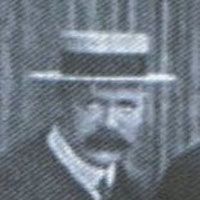Henry 'Harry' J Newbould

Born: Everton, 1861 died: April 1928
1st July 1906 - 31st July 1912
Although born in Liverpool in 1861 Henry, or Harry as he became known to football fans, spent most of his young adult life in Derby. It appears his family were originally from Derbyshire but moved to Liverpool in the late 1850s, prior to Harry’s birth. They moved back to Derbyshire when Harry was approximately five years of age. In his early twenties he worked as a clerk in an iron foundry and, according to later reports, he trained as an accountant. It is known that Newbould was the secretary-manager of his local League side Derby County from 1900 until his appointment at City. At Derby he guided the Rams to a FA Cup final in 1903 and semi-finals in 1904. He was a very popular figure, even though he sold Derby’s first major star Steve Bloomer to Middlesbrough.
When he arrived at City, the Blues were a desperate side. The bribe and illegal payments scandal had decimated the Club from the boardroom down to the pitch, and Newbould had to quickly give direction to both the players and to the administration staff. On the pitch he was left with only eleven players in the entire squad. Off the pitch the Club’s accounts needed to be totally legitimate and perhaps a model example of how to run a football club legally. In both areas Newbould had a lot of issues to face.
On the pitch he quickly found new players to fill the gaps left by the banning of seventeen first team players. Inevitably, some of his new signings failed but quite a few others, most notably Bill Eadie and Jimmy Conlin, became significant stars.
As anticipated Newbould’s first season was difficult with the Blues narrowly avoiding relegation – they finished 17th out of 20. They had also endured an embarrassing 9-1 defeat at Everton in their second game of the season. The following season (1907-08) they finished third, but Newbould’s side had still not recovered from the problems of 1905-07 and inconsistency dogged 1908-09. Newbould's side were relegated in 19th place, but they immediately bounced back as Champions, and Newbould managed - only just - to keep City in the First Division for the following couple of years.
In July 1912 he left the Blues and assisted Academicals (Copenhagen) for a while the following August. He also played a major role with the Manchester based Players' Union, becoming secretary. Earlier Newbould had actually clashed with the PFA over disagreements over an alleged £500 benefit promised, according to the union, to City star Jimmy Buchan. Perhaps he joined the PFA management committee to try and build bridges between managers and players. In March 1913 he became the union’s secretary, and according to the PFA’s own records, Newbould’s reign led to years of ‘hibernation’ for the PFA. One of his main acts was to move the union offices from St. Peter’s Square in central Manchester to his own house in Longsight. He resigned as secretary in 1915, although he actually carried on in the role during the war and by August 1919 he was being paid £7 a week plus £1 for the use of his house as offices.
He died still as the PFA’s secretary in April 1928 after a long debilitating illness.
In terms of actual trophy success, Newbould’s time at Hyde Road saw him win the Second Division title, but nothing else significant, however his reign was never likely to be one judged on trophy success. His mission when he arrived at Hyde Road was to save the Club, and by the time he left it is fair to say he had created a side capable of challenging, of not quite ready to win major honours, and a Club that was free of scandal. For these reasons, Newbould must rank as a major influence in the history of the Club.
All history and statistical material has been produced based on the research and writing of Manchester football historian Gary James (www.facebook.com/GaryJames4). It is maintained by Ric Turner & Gary James. All text remains the copyright of the original contributors.
Gary's book, Manchester - the City Years: Tracing the Story of Manchester City from the 1860s to the Modern Day, is available to order on Amazon.